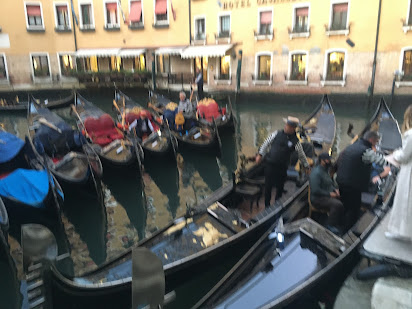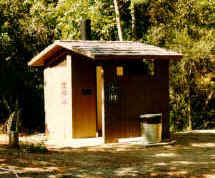I was sorry our gondola ride on the canals of Venice had come to an end. For many reasons, some of which may not seem obvious.
The gondola ride, unlike other parts of the journey, was everything I could have hoped for.
• The boat: Beautiful, flat-bottomed, made of various types of beautiful (and beautifully finished) wood, highly decorated with the traditional “Dolfin” at the bow and the standing platform at the stern for the gondolier.
• The colors: Black lacquer and gloss white with gold trim.
• The gondolier: Strong and capable.
• His attire: Traditional, with straw boater hat and navy woolen jacket over a white sailor’s shirt.
• His voice: Booming and full as he executed traditional, soaring operatic pieces.
• The cost: Fifteen Euros each. This seemed reasonable considering the Euro and U.S. Dollar were within twenty percent of equity at the time of our visit to Venice.
 |
| Gondolas in Venice. Photo by author. |
Ride or no ride, I wanted a rest.
Our ride began after 6:30 in the evening on October 24th. It was dark, damp, breezy, and cool. The boarding process was. After paying our fee (cash only!) we were escorted down four steep (and slippery-looking) steps to the edge of the canal’s water. After the gondolier positioned his craft, we were handed across the gap and over the gunnel with one, rather large, step down to the deck, the gondola rocking through the process. I felt a real sense of apprehension about the dark and likely cold waters under the boat. Once aboard, we were directed to our cushioned seats. We managed sitting without falling into or out of the boat, we were settled but still out of breath, and the ride began. We were pleasantly surprised there was no stale canal rotten-egg odor. Rather we noted a slightly sweet, salt-water smell. Our gondolier explained the canals in Venice are not stagnant but are flushed with tidewater from the sea twice each day by natural action and the canal water levels were managed by a series of ingenious dams and weirs.
With strong and steady exertion, the gondolier pushed his steed away from the landing and into the middle of the murky canal, the dark space only slightly wider than two of the shiny craft, stone and brick buildings on either side. We soon passed under a bridge and into a more open area. Here, the moonlight penetrated better, and we were relieved from the oppressive darkness of the earlier narrow stretch of canal. With greater light, we could appreciate the beauty of the buildings and the narrow walks along each side. As the gondolier, deep in his rendition of a barcarolle song, pushed us on with the boat’s rémo (pushing pole) we glided peacefully past the historical sights of Venice: palaces, churches, museums, and hotels.
Our gondolier, Enrico, told us it takes four years of training and apprenticeship, followed by a difficult exam, to qualify for a gondolier’s license. Venice limits the licensed gondoliers to a maximum of 400. In olden days, licenses were passed from father to son, but that is no longer allowed, and each must stand for exam on his (or her) own. Yes, there are female gondoliers. The gondola itself is a true work of art. Each new one costs about 50,000 Euros. Enrico said he loved his job and especially loved singing for beautiful women from around the world. Glenda averted her eyes. Was that a slight blush in her cheek?
Soon, the walkways opened a bit, accommodating café seating. Diners, mostly couples, were enjoying a meal or a drink under the moonlight as we slid past and entered the Grand Canal. Some waved to us as we glided past. Within moments, a noisy powered police boat sped past us running under siren and leaving a wake that rocked our gondola. Without cars, the old part of the city depends on fast speedboats to get police, fire, and other emergency services where they are needed. The next vessel was a stately funeral barge, returning from its day’s work transporting the dead to Isola di San Michele, the island that is Venice’s largest cemetery. The barge, painted a brilliant blue, was also powered, but running at a much more sedate speed, creating no visible wake. Powered vessels are not uncommon on the Grand Canal, Venice’s watery main street, as the commerce of the city must go on, even for departed souls. Unlike the gondola, powered vessels always run with lights at night.
 |
| Rialto Bridge. Photo by author. |
We soon passed under the Constitution Bridge, Rialto Bridge, the Ponte dell’ Accademia, and finally the covered Bridge of Sighs over the part of the canal system called the Rio di Palazzo. Each bridge is unique and presents its personality expressed in architecture, size, construction materials, and color. Our gondolier explained the story of the Bridge of Sighs: It was the last part of Venice you would see if you were being shipped off to prison or otherwise banished from the beautiful city.
Too soon, it seemed, we had slipped across the glassy canals and had returned to the landing. Still, after the peace and beauty of the ride, I was refreshed, almost feeling like I was awakening from a dream. I was sorry the ride had come to its end. One reason was that I feared the fast-walking torture would recommence.
As stragglers, we had been among the last to board a gondola and among the last returning to the landing. We soon learned our group had gathered in a convenient gelateria and enjoyed the typical sweet, icy treat while awaiting the last of the group’s return. But sorry, not enough time left now for gelato. We must be on our way. A real visit to St. Mark’s would have to wait until tomorrow. At leaste the return trek wasn’t so hurried. As the noisy and smoky water taxi pulled away from the waterfront, I felt a wave of nostalgia for the sound of the gondolier’s singing voice and the sweet-salty smell of the canal.
I’d go back to Venice.
Without the comforting gondola ride, I’m not sure that I would say that.
 |
| Sunset over a restful ride. Photo by author. |
